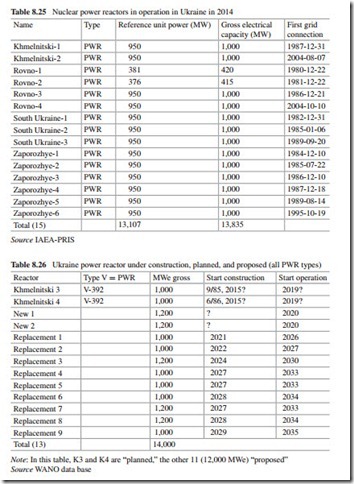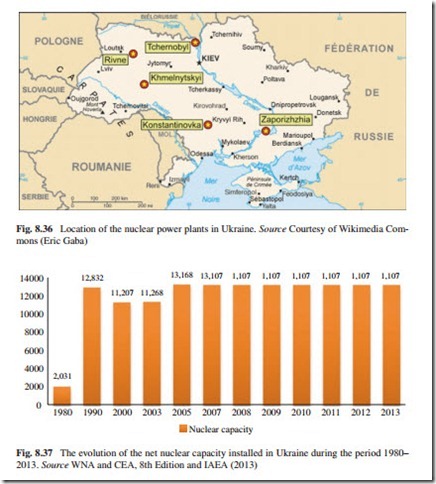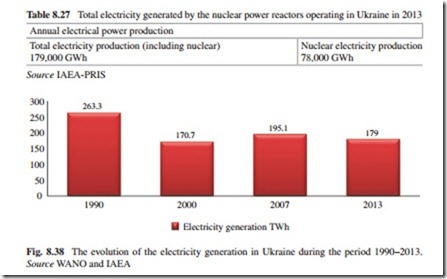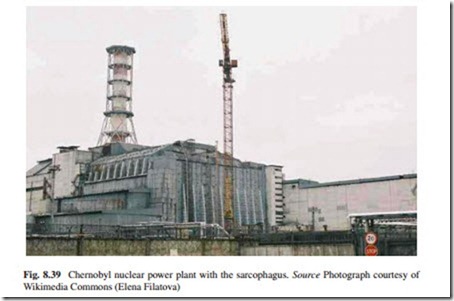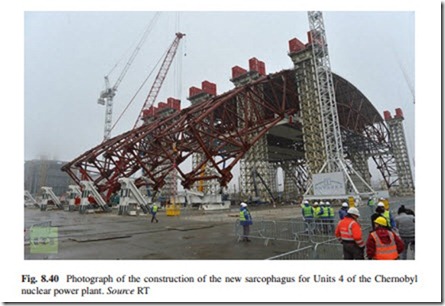Ukraine
In the case of Ukraine, the main energy sources available in the country are uranium and coal. According to IAEA source, “the confirmed coal reserves in the country could cover the Ukraine’s energy needs for 200–300 years.” The country imports mostly all of their needs in oil and gas from Russia. A large share of primary energy supply in Ukraine comes from the country’s uranium and substantial coal resources. After the breakdown of the Soviet Union in 1991, the country’s economy collapsed and its electricity consumption declined dramatically from 296 billion kWh in 1990 to 170 billion kWh in 2000, all the decrease being from coal and gas power plants.
In 2014, in Ukraine have 15 nuclear power reactors in operation with a total of 13,107 MW of capacity and producing 43.58 % of the total electricity generated in the country in that year (see Tables 8.25 and 8.26).
The government is constructing two new units with a capacity of 2,000 MWe and has plans for the construction of 11 new nuclear power reactors in the future with a net capacity of 12,000 MWe. The nuclear power reactors under construc- tion, planned, and proposed are included in Table 8.26.
The locations of the nuclear power plants in Ukraine are the following: South Ukraine, Zaporizhzhe Rivne (or Rovno), Khmelnitsky, and Chernobyl (see Fig. 8.36).
The nuclear net capacity installed in the country increased from 11,268 MWe in 2003 to 13,107 in 2014; this represents an increase of 16.3 %. This increase was due to the addition of two new WWER-1000 nuclear power reactors, Khmelnitski 2 and Rovno 4, which entered into commercial operation in December 2005 and in April 2006, respectively. The cost of completing these two units was estimated to be around US$1,236 million (US$621 million for the Khmelnitski 2 and US$642
million for Rovne 4). The evolution of the net nuclear capacity installed in the country during the period 1980–2013 is shown in Fig. 8.37.
All nuclear power reactors installed in Ukraine are Russian WWER systems of three different generations. Out of the 15 nuclear power reactors currently in
operation in the country, two are 440 MWe V-213 models of second generation, two are the larger WWER 1000, V-302, and V-338 second generation, and eleven are WWER-1000, V-320 third generation.
Electricity Generation Using Nuclear Energy
In 2013, the country generated 179 TWh of electricity out of which 43.48 % was produced by the nuclear power plants operating in the country (see Table 8.27).
From Fig. 8.38, the following can be concluded: During the period 1990–2000, the electricity generation in the country fell from 263.3 TWh in 1990 to 170.7 TWh
in 2000; this represents a decrease of 65 %. Since 2000, the generation of electricity shows a modest increase from 170.7 to 195.1 TWh in 2007; after this year, the generation of electricity registered another decrease and in 2013 produced 179 TWh. Taking into account the whole period under consideration, it can be said that the generation of electricity in Ukraine using all types of energy sources decreased 23.3 %.22 Despite the decrease in the generation of electricity registered in Ukraine during the period 1990–2013, it is expected that the demand of electricity increase up to 307 billion kWh per year by 2020 and 420 billion kWh by 2030. Regardless of the Chernobyl nuclear accident and the shutdown of four of its units, the policy of the government is to continue supplying approximately half of its energy demand from nuclear power plants. To achieve this goal, the country will require 29.5 GWe of nuclear capacity in 2030.
In mid-2011, the Ukraine energy strategy up to 2030 was updated, and in the electricity sector the role of nuclear powers was emphasized, with improved safety and increased domestic fuel fabrication. In mid-2012, the policy was again updated, and 5,000–7,000 MWe of new nuclear capacity was proposed by 2030, costing some US$25 billion. The new government formed in 2014 has confirmed these targets and said that Ukraine aimed to integrate with the European power grid and gas network to make the country part of the European energy market by 2017.
In September 2014, the new government introduced a bill to parliament that will allow the sale of 40 % of ENERGOATOM to a foreign investor. This
followed an announcement that the Prime Minister expected agreements for new nuclear power reactor construction to be signed by the end of the year, possibly for Western designs. However, refurbishment of older nuclear power plants to extend operating lives and bring them into conformity with EU standards seems more probable, both economically and regarding timescale. WESTINGHOUSE is a leading contender for this work.
According to Table 8.28, a total of four nuclear power reactors were permanently shutdown in Ukraine, all of them located in the Chernobyl nuclear power plant.
The Chernobyl Nuclear Accident
According to Morales Pedraza (2013), the Chernobyl nuclear power plant (see Fig. 8.39) is located near the town of Pripyat, which had been built to house power
plant employees and their families. The nuclear power plant was constructed in a wooded, marshy area near the Ukraine–Belarus border, approximately 18 km Northwest of the city of Chernobyl and 100 km North of Kiev, the capital of Ukraine. The Chernobyl nuclear power plant included four nuclear power reactors (RMBK type), each capable of producing 1 GW of electric power. At the time of the accident, the four reactors produced about 10 % of the electricity used in Ukraine.
Construction of the Chernobyl nuclear power plant began in the 1970s. The first of the four reactors was commissioned in 1977, and Unit 4 began producing power in 1983. When the accident occurred in 1986, two other nuclear reactors were under construction. The Chernobyl nuclear accident is the worst nuclear accident ever occurred at a nuclear power plant, considering the area contaminated, the number of countries involved, and the amount of people affected by the accident. What caused this terrible accident from the environment and human health point of view? Initially, the accident at Unit 4 of the Chernobyl nuclear power plant was considered as resulted from a combination of design and technical deficiencies in addition to a grave operator error. However, in a later report, the IAEA put the main cause of the accident to the reactor’s design. What really happens? According to WNAO’s report, on 25 April prior to a routine shutdown, the reactor crew at Unit 4 of the Chernobyl nuclear power plant began preparing for a test to determine how long turbines would spin and supply power to the main circulating pumps following a loss of main electrical power supply. This test had been carried out at the Chernobyl nuclear power plant the previous year, but the power from the turbine ran down too rapidly, so new voltage regulator designs were to be tested.
Which was the purpose of the test to be performed in Unit 4 of the Chernobyl nuclear power plant in April 1986? It is well known that nuclear power plants not only produce electricity, but they also consume electricity, for example to power the pumps that circulate the coolant. This electricity is usually supplied from the grid. If the source of electricity failed, most nuclear power reactors are able to derive the required electricity from their own production. However, if the reactor is operating, but not producing power, for example, when the reactor is in the process of shutting down, some other sources of supply are required. Generators are generally used to supply the required power, but there is a time delay while they are started. The test carried out at Unit 4 of the Chernobyl nuclear power plant was designed to demonstrate that a coasting turbine would provide sufficient power to pump coolant through the reactor core while waiting for electricity from the diesel generators. The circulation of coolant was expected to be sufficient to give the nuclear power reactor an adequate safety margin.
A summary of the main events associated with the nuclear accident in Unit 4 of the Chernobyl nuclear power plant is described in detail in Morales Pedraza (2012, 2013).
As consequence of the nuclear accident, some 150,000 km2 in Belarus, Russia, and Ukraine were contaminated and stretch northward of the nuclear power plant site as far as 500 km. An area of 30 km around the nuclear power plant site was considered the “exclusion zone” and is essentially uninhabited. Radioactive fallout scattered over much of the Northern hemisphere via wind and storm patterns, but the amounts dispersed were in many instances insignificant. Cesium and other radioactive isotopes were blown by wind northward into Sweden and Finland and over other parts of Europe and the Northern hemisphere. During the first three weeks after the accident, the level of radiation in the atmosphere in several places around the globe was above normal, but these levels quickly receded reducing the consequences of the Chernobyl nuclear accident for many countries. In January 1993, the IAEA issued a revised analysis of the Chernobyl nuclear accident, attributing the main root cause to the reactor’s design and not to operator error.
In 2005, the IAEA and the World Health Organization (WHO) reported that “only 56 people had died directly from the incident, mainly accident workers.24 They estimated another 4,000 deaths among workers and local residents.” Some 8 tons of the 140 tons of fuel, which contained plutonium and other highly radioac- tive materials (fission products), were ejected from the reactor along with a portion of the graphite moderator, which was also radioactive. These materials were scat- tered around the nuclear power plant site. In addition, cesium and iodine vapors were released both by the explosion and during the subsequent fire.
After the Chernobyl nuclear accident, the pressure of the international commu- nity to close nuclear power plants in operation in many countries increased signifi- cantly, independently of the type of nuclear power reactors used for the generation of electricity.
In 1995, a memorandum of understanding was signed between the governments of the G-7 countries, the EC, and the Ukraine government, agreeing with the closure of all Chernobyl nuclear power reactors. Based on this memorandum, Unit 2 was shutdown in October 1991 after a huge fire in the unit, Unit 1 in November 1996, and Unit 3 in December 2000. Following the Chernobyl nuclear accident, Unit 4 was encased in a giant concrete sarcophagus (See Fig. 8.40), constructed above the destroyed reactor by hundreds of thousands of soldiers and civilian, including nuclear experts, to prevent further leakage of radioactive material.25 However, the sarcophagus built in 1986 was unstable and was close to collapse at the beginning of the 2000s. For this reason, a stabilizing steel structure was extended in December 2006 to spread some of the load on the walls damaged by the explosion.
After the reinforcement of Unit 4 carried out in 2006, the structure of that unit even represented a serious potential threat to the Ukraine population, if actions are
not taken as soon as possible by the government to repair the whole structure of the sarcophagus. But these actions were not enough to stabilize the damage steel structure. Having been seriously damaged by the 1986 nuclear accident and subsequently repaired, the roof of the turbine hall adjacent to the reactor building partially col- lapsed in February 2013, but fortunately released no radiation and had no effect on the shelter that protects the highly radioactive remains of Unit 4. According to some Russian nuclear experts, the collapse of the roof has been caused by the weight of the snow. However, managers of the nuclear power plant requested support from the IAEA in the preparation of the report. For this reason, the IAEA expert team was sent to the plant site in June 2013, with the aim of assessing the entire turbine hall where the roof section fell. A full report on the causes of the collapse was presented to the director general of the Chernobyl nuclear power plant in July 2013.
Lesson Learned
According to WANO sources and reports, including other public sources and experts’ opinions, the following are the summary of the main lesson learned from the Chernobyl nuclear accident:
• The need to adopt the so-called “safety culture” by all countries with nuclear power plants in operation. This “safety culture” was promoted by the IAEA after the accident in order to increase the safety of all nuclear power reactors operating in all countries. In addition, the IAEA promoted the adoption of specific measures to further strengthen nuclear safety regulatory authorities in almost all countries, including the independence of these authorities from other government offices. The IAEA also elaborated new safety documents with the purpose of increasing the safety operation of all nuclear power reactors.
• The need to upgrade all RBMK units operating in the former Soviet Union and in other former Eastern European countries with the purpose of eliminating all identified design deficiencies that contributed to the Chernobyl nuclear accident, to improve shutdown mechanisms, redesigned control rods, faster control rod mechanisms, changes of fuel enrichment to reduce the effect of the positive void coefficient, and heighten general safety awareness among staff ;
• The importance of improving current training programs for the preparation of nuclear power plant operators in Russia and in other countries with important nuclear power programs as well;
• In the specific case of the Chernobyl nuclear accident, when the operators noticed the sharp increase in power, they attempted to insert the control rods into the reactor core. This did not help because the rods could not move fast enough. When the operators started to push the control rods back in, the boron carbide parts were completely clear of the reactor core. Below the graphite part was a column of water. Inserting the rods initially had the effect of pushing the water away, which meant decreasing the amount of poison which meant increasing “k.” The intense heat deformed the reactor core and the control rods stuck before they could be completely inserted. The control rods were badly designed. Several measures were adopted to redesign the control rods in these types of reactors.
• The lack of a strong concrete building surrounds most Western reactors was not in place around Unit 4 or around any other of the three units in the Chernobyl nuclear power plant. If it did, radiation might not have leaked into the environment.
• One of the consequences of the Chernobyl nuclear accident was the decision adopted by Russia and other former European countries of abandoning the use of RMBK reactor type for the generation of electricity and the decision not to construct new nuclear power reactors of this type inside or outside Russia.
Finally, it is important to highlight the following: The accident would not have happened unless the operators had made several serious errors. First of all, the tests should have been aborted when things were not going as planned. The power level was lower than planned, increasing the importance of the positive void coef- ficient. The core of the reactor was suffering from severe xenon poisoning, so the control rods had to be almost fully retracted, leaving a very small margin of safety. The operators seemed completely unaware of the fact that the effect of xenon poisoning would decrease rapidly, should the power level rise.
Summing-up the following can be stated: The nuclear accident at the Chernobyl nuclear power plant is the resulted from a combination of external circumstances, engineering design flaws, and errors made by badly trained operators. The biggest challenge facing the people affected by the Chernobyl nuclear accident is the psycho- logical damage to five million people in Belarus, Ukraine, and Russia. The psycholog- ical impact is now considered to be Chernobyl’s biggest health consequence because people consider themselves as victims of the accident and are, therefore, more apt to take a passive approach toward their future rather than developing a system of self-sufficiency. The Belarus National Academy of Sciences estimates 270,000 people in the region around the accident site will develop cancer as a result of Chernobyl radiation and that 93,000 of those cases are likely to be fatal. In another report, the Russian Academy of Sciences has found a dramatic increase in mortality since 1990—60,000 deaths in Russia and an estimated 140,000 deaths in Ukraine and Belarus—probably due to Chernobyl radiation.27
The Public Opinion
According to Morales Pedraza (2012), the sociological service of the Razumkov Center conducted two national opinion polls among 2,010 and 2,008 respondents over 18 years of age between April 23 and April 28, and between May 27 and June 2.28 The outcome of the poll shows that the Chernobyl consequences and construction of new nuclear power reactors are not the most serious societal concerns in comparison with low incomes, unemployment, and crime. The Chernobyl problems rated only fourth among the six gravest concerns (these worried only 14.1 % of respondents). The construction of new nuclear facilities worried twice fewer respondents 7.4 %. At the same time, respondents over 40, who remember the Chernobyl disaster very well, are concerned more deeply than those aged under 40: 15 % versus 12.8 %. This problem appears a lot more serious to residents of the areas where nuclear facilities are located than residents of other parts of the country: 17 % versus 13.6 % on the Chernobyl issue; 12.5 % versus 6.5 % on the issue of construction of new nuclear power plants (Saprykin 2005).
Another important result of the poll is that prospects for nuclear power generation appear more realistic to residents of the areas where nuclear power plants are located than respondents in other parts of Ukraine: 36 % versus 26.3 %, respectively. On the whole, Ukrainians believe that the nuclear industry is a positive fac- tor in achieving the country’s energy independence (39.3 % vs. 30 % of those who do not). This opinion is prevalent among younger respondents (44 %) and residents of nuclear-free areas (39.4 % vs. 28.3 %). In the areas where nuclear facilities are located, the opinions on this issue split almost equally: 39.4 % versus 40.4 %.
Despite of the Chernobyl nuclear accident and how the accident was handled by the soviet nuclear authorities, in addition to the negative impact of the accident on the environment and the population living in the surrounding area of the Chernobyl nuclear power plant, only 24.6 % of Ukrainians consider nuclear power plants extremely dangerous and 40.3 % appraise them as substantially dangerous. On the other hand, very few respondents (3.5 %) believe that Ukrainian nuclear power plants are absolutely safe; 24.1 % of respondents assess them as relatively safe and 7.5 % are undecided. It is important to single out that there is a notable difference between the assessments of nuclear safety levels by residents of areas where nuclear facilities are located and residents living outside these areas. The former appears to be more rational than the latter: a mere 0.3 % of residents living near of nuclear industry areas believe that Ukrainian nuclear power plants are absolutely safe versus 4.1 % of respondents living in areas where no nuclear facilities are located.
Regarding the necessity to build new nuclear power reactors the replies were the following: 54.9 % of the respondents consider that there is no need to construct new nuclear power plant in the country, while 26.8 % are in favor and 18.3 % undecided. One of the outcomes of the poll reflects that there are more opponents to such construction plans among residents of areas where nuclear power plants are located and among older respondents: 60.6 % versus 53.9 % and 58.5 % versus 49.5 %, respectively.
Regarding the plan of the government to construct 11 new nuclear power reactors by 2030, the idea was supported by 19.9 % of respondents, while 57.2 % were against; 9.6 % were indifferent, and 13.3 % were undecided.29 The plan of the gov- ernment to construct 11 new nuclear power reactors in the coming years was rejected by activists promoting the following action: “NO to new reactors, YES to energy conservation!” near the Cabinet of Ministers of Ukraine in Kiev. The plans were announced in May 2005 and later confirmed at parliamentary hearings on the development of Ukraine’s energy sector. “We are not calling for the immediate closure of nuclear power plants in Ukraine, but we do oppose new construction and life extensions,” said Yevgeny Kolishevsky, executive director of the Voice of Nature NGO. “We strongly demand that the new government of Ukraine includes a set of concrete measures aimed at increasing energy efficiency in all sectors of the Ukrainian economy into the Energy Strategy of Ukraine for the period till 2030, Decree of the Cabinet of Ministers of Ukraine No 145 of 2006.” Yury Urbansky, from the National Ecological Centre of Ukraine and CEE Bankwatch Network, said, “We have serious concerns about the safety of Ukraine’s nuclear power plants. The implementation of the state program of a safety upgrade for existing nuclear power has failed, the parliament ratified loans provided by the EBRD and EUROATOM for the modernization of Khmelnitsky 2 and Rivne 4 commissioned in 2004 with a one year delay, problems connected with radioactive waste management continue to go unsolved and there are no signs of progress in the near future” (Saprykin 2005).
A new World Public Opinion poll of 21 nations founds very strong support for the government requiring utilities to use more alternative energy, such as wind and solar, and requiring businesses to use energy more efficiently, even if these steps increase the costs of energy and other products. Fewer than half of the nations polled favor putting more emphasis on nuclear energy or on coal or oil. In the case of Ukraine, 56 % were in favor to use an alternative energy source for electricity production and 49 % put more emphasis on increasing of the efficiency in the gen- eration of electricity than in the use of nuclear energy for the same purpose.
In a poll of 20,790 respondents conducted between July 15 and November 4, 2008, by WorldPublicOpinion.org, a collaborative research project involv- ing research centers from around the world and managed by the Program on International Policy Attitudes at the University of Maryland found that nearly half (49 %) of the respondents in Ukraine say the building of nuclear power plants should receive less emphasis, while only 9 % believe they should receive greater emphasis. This position of the public opinion in Ukraine is the influence of the fear of having a second nuclear accident in the country.
Finally, it is important to highlight that the current situation in Ukraine is making more difficult than before the implementation of any plan for the expansion of the current nuclear power program.
Looking Forward
The Ukrainian parliament voted to lift the moratorium on new nuclear power plant con- struction cited Ukraine’s energy shortage as the reason why the decision was adopted. The vote cleared the way for completion of three partly built WWER-1000 units— Zaporozhye 6,30 Rovno 4, and Khmelnstkiy 2 (Nuclear power in Ukraine 1997, 2008).
In February 1994, the President of Ukraine issued a directive calling for the completion, by 1999, of five WWER-1000 s units under construction: Zaporozhe 6, Rovno 4, Khmelnitsky 2, 3, and 4. In the case of the Khmelnitsky 2, the financial resources need to complete the construction of the unit were estimated at US$257 million. For Rovno 4, the financial resources to complete the construction work of this unit were estimated at US$267 million. The Ukrainian’s Energy Minister approved a contract for the continuation of the construction of the Khmelnitsky’s nuclear power plant. The contract was given to a Russian company ATOMSTROYEXPORT. The estimated cost of the work is of about US$4,000 million, and it will be financed in 85 % with a Russian loan. The remaining 15 % will be financed with funds provide by Ukraine.
At the end of 1995, Zaporozhe Unit 6 was connected to the grid, making Zaporozhe the largest nuclear power plant in Europe, with a net capacity of 5,700 MWe and the fifth in the world.31 In August and October 2004, Khmelnitsky 2 and Rovno 4, respectively, were connected to the electric grid, bringing their long and interrupted construction to an end and adding 1,900 MWe to replace that lost by closure of Chernobyl 1 and 3 in 1996 and 2003, respectively.
The 2006 strategy adopted by the government envisaged completing Khmelnitski 3 and 4, which were, respectively, 75 and 28 % complete when work stopped in 1990. The government announced in September 2008 that construction on these would resume in 2010 for completion in 2016 and 2017. These completion dates were reaffirmed in mid-2010 and in the mid-2011 energy policy update. In February 2011, it signed a framework contract for construction with ATOMSTROYEXPORT for AES-92 plants with V-392B reactors similar to those already on the site. In June 2010, an intergovernmental agreement was signed, under which Russia will largely finance the project. Some 85 % (€3.7 billion) of the project is to be financed through a Russian loan, with 15 % funding coming from Ukraine. The loan is to be repaid Following the breakup of the USSR, spent fuel could no longer be transported to Russia and the shortage of free space in the cooling pools demanded a spent fuel dry storage facility (SFDSF) at the site. Zaporizhye is the first Ukrainian nuclear power plant with VVER-type reac- tors to include a SFDSF.
The spent nuclear fuel from the reactors is stored in cooling pools for four to five years until their residual energy and radioactivity decrease. It is then transferred to the SFDSF. The storage system can accommodate more than 9,000 spent fuel assemblies in 380 ventilated storage casks. The facility began operations in August 2004 and 80 casks have already been installed on the site.
The second largest nuclear power plant operating in Europe is Gravelines, near Dunkerque in France, with six PWR nuclear power reactors with a total net capacity of 5,460 MWe.
within five years after the reactors go into service. In July 2012, the government confirmed the feasibility, costs, and timing of the project—US$4.9 billion total. The loan agreement was expected to be finalized by the end of 2012. At the end of 2013, the energy minister said that construction might resume in 2015. The mid-2011 energy policy revision proposes 2,300 MWe of new capacity with decision on technology to be over 2015. Following this, there will be a need for replacing current nuclear power plants, which are decommissioned in the 2030s. ENERGOATOM proposes to select a standard PWR (or possibly CANDU) design from among leading vendors for the remaining planned units after Khmelnitski 3 and 4. This will involve consideration of local content in the plants. While Russian VVER technology is the most obvious fit, ENERGOATOM’s ATOMPROEKTENGINEERING division provided a feasibility study recommending making provision for use of CANDU EC-6 reactors to the ministry in October 2010. Nevertheless, the situation in Ukraine and the confrontation with Russia regarding the annexation of Crimea and the support of Russia to the rebellion in the Eastern part of the country halted the implementation of these agreements.
It is important to highlight that all nuclear power reactors in Ukraine have already reached 50 % of their designed service life. During the period from 2013 till 2020, eight WWER-1000 and two WWER-440 units now in operation should be shutdown. To compensate any possible loss of power due to the closure of any of the mentioned units and to take care of the foresee increase in the consumption of electricity in the country in the coming years, Ukraine authorities have taken a decision to build more new nuclear power reactors and extending the life of 13 of the existing PWRs systems currently in operation. These measures will ensure that nuclear power continues to represent about 50 % of electricity generated in Ukraine in the near future. The main driving force behind the support for nuclear power is the desire of the Ukraine authorities to reduce dependence on Russian oil and gas.
